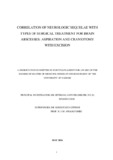| dc.contributor.author | Hitimana, Janvier | |
| dc.date.accessioned | 2016-11-18T08:05:39Z | |
| dc.date.available | 2016-11-18T08:05:39Z | |
| dc.date.issued | 2016-05 | |
| dc.identifier.uri | http://hdl.handle.net/11295/97546 | |
| dc.description.abstract | Background: Pyogenic brain abscesses are life threatening conditions that require urgent surgical and medical treatment. Neurologic sequelae of pyogenic brain abscesses and or surgery include hemiplegia, monoplegia, visual defects, cognitive dysfunction, hydrocephalus and seizures. Currently the association of surgical techniques with neurologic sequelae is not clear; the goal of this study was to study a correlation between them.
Objective: Evaluate the correlation between neurologic sequelae among patients operated for brain abscesses in relation to the types of surgical techniques.
Study design: Descriptive observational study.
Setting: Kenyatta National Hospital. Nairobi, Kenya.
Methodology: After obtaining approval from the department of surgery and Ethics and Research Review Committee, the study proceeded to data collection. Patients diagnosed and with pyogenic brain abscesses and on follow-up in neurosurgery clinic for 6 months or more after surgery were included in the study. Preoperative and postoperative neurologic deficits were recorded.
Duration of study: 8 months (September 2015 - April 2016).
Results: 34 patients were included in the study. Penetrating brain injury and depressed fractures were the most common causes of brain abscesses in our study (44.12%, n=15). Infections from paranasal sinuses were 6 (17.65 %) and middle ear infection was found in 1 patient (2.94%). The duration of symptoms ranged from 4-180 days. Headache was the most common finding at presentation and was recorded in 25 patients (73.53%). Vomiting was a presenting sign in 14 patients (41.18%); fever as a presenting sign was found in 14 patients (41.18%); and seizures were seen in 13 patients (38.24%). Altered
xiii
mental status was found in 14 patients (41.18%). All 34 patients had a CT scan of the head before surgery. Most of abscesses were located in the frontal lobes (58.82%) and were single abscesses (97.2%). 21 patients had craniotomy and excision of the capsule (61.76%); 13 patients (32.24%) were treated with aspiration. Recurrences were more frequent after aspiration techniques. Postoperative seizures were found in 38.24% (n=13) of the patients.
Conclusion: The most common causes of brain abscesses were previous head trauma, followed by paranasal sinus infections. Craniotomy was the most commonly performed operation and resulted in definitive cure in all cases. Half of the patients treated with aspiration techniques underwent a repeat surgery. Neurologic sequelae were not different between patients treated with craniotomy and those who underwent aspiration techniques | en_US |
| dc.language.iso | en | en_US |
| dc.publisher | University of Nairobi | en_US |
| dc.rights | Attribution-NonCommercial-NoDerivs 3.0 United States | * |
| dc.rights.uri | http://creativecommons.org/licenses/by-nc-nd/3.0/us/ | * |
| dc.title | Correlation of neurologic sequelae with types of surgical treatment for brain abscesses: aspiration and craniotomy with excision | en_US |
| dc.type | Thesis | en_US |
| dc.description.department | a
Department of Psychiatry, University of Nairobi, ; bDepartment of Mental Health, School of Medicine,
Moi University, Eldoret, Kenya | |



